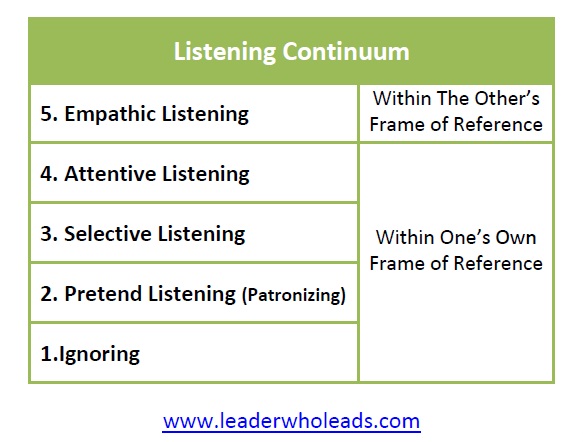
What Are The 5 Levels of Listening?
Learn How It Would Help Us Through The Virtual Reality Educational App
“Seek first to understand, then to be understood.” Stephen R. Covey
The power of persuasive and influential speech is a skill many attempts to master to better present their ideas intellectually. Millions of people take public speaking, address, and even storytelling classes to improve their comfort and effectiveness when speaking.
But there is one key element these classes lack demonstrate: the power of listening.
DEC 13, 2021
In his best-selling book The 7 Habits of Highly Effective People, Stephen Covey states that most people with practical communication skills are good listeners. He presents 5 different levels of listening and how each communication type can either negatively or positively affect our relationships.
The 5 Levels of Listening
1. IGNORING LISTENING
2. The lowest level of listening is called ignoring or not listening at all. It is when we expend zero effort to attend. If you are distracted while talking to a user, it is easy to get the impression that you are ignoring them. This happens to be most people’s most significant weaknesses, as it can be challenging to get our brains to focus on the topic at hand when we have 10 other pressing issues we must address. Without effective listening and full attention, it results in a lack of listening and communication skills.

Ex: Most often, we see this ignoring in the form of cell phone usage while the other person is speaking, starting a different conversation or even interjecting an obscure comment. Even nonverbal cues such as looking utterly aware of the other person or even turning your back to the speaker indicate that you might be distracted from what the speaker is trying to say.
1. PRETENDING LISTENING
2. Pretending (patronizing) is the next level of listening. At this level, we are at least giving the appearance of hearing, as the name indicates. This type of listening will work sometimes, but the second we are asked a question related to what they were saying, Bam! We’re caught!
Ex: This type of listening is what we program ourselves to do when making “small talk.” We do not really care what the other person has to say but are pretending to care for the sake of “niceness.” This listening is especially present virtually, as interactions shift to online video meetings. It happens when you say things like “I see” and “Ok,” while working on an unrelated email or playing a computer game. People can tell you are distracted.

1. SELECTIVE LISTENING
2.Selective listening is a step in the right direction, as it does involve at least a basic level of listening. During selective listening, we pay attention to the speaker as long as they discuss things we like or agree with. If they move on to other things that lose our interest, they also lose our attention. We slip down to pretend to listen or ignore them altogether. This type of listening can frequently result in increased miscommunication and misunderstanding as the parties potentially hear different parts of the exchange.
Ex: This example is best seen in conflict. Let’s say your manager gives you feedback on how well you did with an assignment. While they’re explaining what you could have done better, you’re already thinking about your defence. You are only present for the topics that pique your interest and choose to tune out the rest and consider your own thoughts before hearing fully what the speaker has to say.
1. ATTENTIVE LISTENING
Attentive listening is the level we most frequently seek to achieve in our day-to-day interactions, especially in the work environment. It occurs when we carefully listen to the other person and internalize the part of the message but decide whether we agree or disagree or whether they are right or wrong. Instead of paying close attention to the other person, we’re formulating our response to what they are saying. At all four of these levels, it should be evident that we are listening to our own perspective, and in most cases, with the intent to respond from our experience.
Example: This type of listening works well for our professional lives and our personal as well. When we discuss a complex topic without our S.O’s, we want our tone, body language and message to indicate that we are engaged and seeking to understand.
This usually involves eye contact, thinking to understand, reflecting, rephrasing, and other tools to keep us fully engaged. However, even at its best, this level of listening is still based upon relatability to our own individual experience or frame of reference.
We still have an even more advanced level of listening we can achieve.
1. EMPATHETIC LISTENING
The fifth level of listening is Empathic Listening, also known as empathetic listening, the top level of listening. It is the highest level of hearing because it requires the most significant amount of mental and emotional energy. It takes discipline and practice to see it through the eyes of the other person. It reaches beyond attentive listening because it requires us to focus on and seek the other person’s frame of reference using our full listening faculties, plus our heart and mind.
For example, say your child comes home from school and says, “I hate my teacher.” A parent’s normal (yet un-empathetic) reaction might be, “Don’t say things like that about your teacher,” or “What did you do wrong?” A better response would be, “You sound upset. Tell me what’s going on.” Again, this shows a desire to know the deeper feelings of the person rather than what is being initially presented.
This listening is the key to being a successful spouse, friend, boss, or employee. You must teach yourself to treat every problem as though this is the first time you’ve ever heard it, showing a desire to understand the issue deeper and resolve it for the OTHER person’s sake. This requires us to slow down, be patient, talk less, listen more, and repeat what was said to ensure we don’t overlook anything.
What Does Empathetic Listening Look Like In My Life?
Mindfulness Leader Gisele Wyne has been leading wellness training for over 10 years, teaching the essential relationship skills most people lack.
Learning this higher level of listening has dramatically changed how people are perceived and how they can create lasting relationships.
“Everyone is taught how to speak, write, and externally present themselves, but so few people are actually taught how to listen. Learning to listen is a straightforward and effective skill that deepens relationships and connections like no other. This will make you feel more valued by your peers and create confidence in romantic relationships,” Wyne states.
She believes this simple is so overlooked that most people do not realize that the way they currently listen could be demolishing current relationships and preventing us from growing our network.
“Just by learning the 5 levels of listening, we can understand that simple tweaks can completely transform a relationship.”
How do I achieve Empathic Listening?
A great way to evaluate whether you’re doing empathic listening or not is to ask yourself, “WHERE IS MY FOCUS?”
As you think about the 5 levels of listening, believe that the first four levels are self-focused, while the fifth level (empathic listening) is focused on the user. When your focus is entirely on the user and not on yourself, your level of service will be much higher.
“To truly listen to means to transcend your autobiography, to get out of your own frame of reference, out of your own value system, out of your own history and judging tendencies, and to get deeper into the frame of reference or point of view of another person. This is called empathic listening. It is a very, very rare skill. But it is more than a skill. Much more.”
– Stephen R. Covey, The 8th Habit














